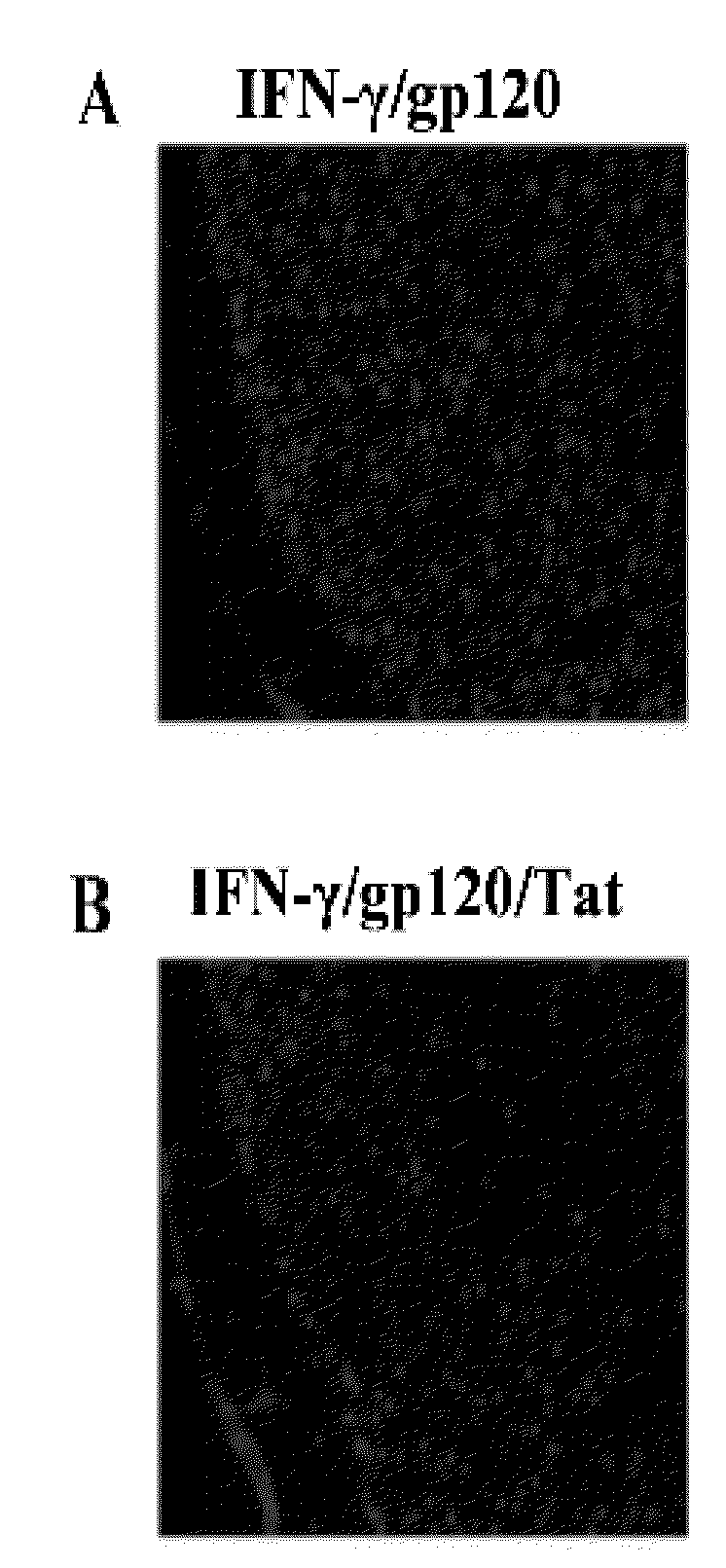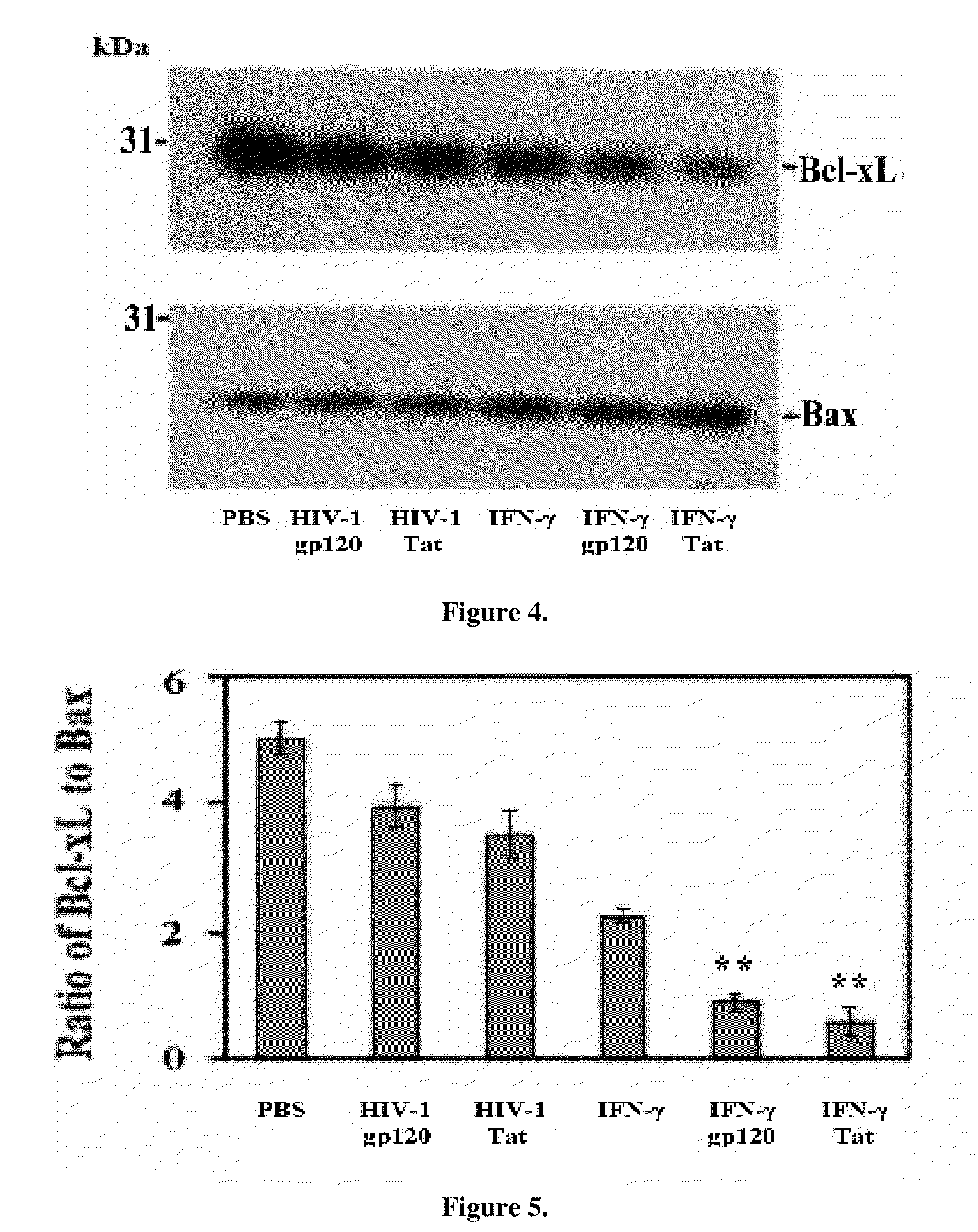Neurodegenerative disease treatment using jak/stat inhibition
- Summary
- Abstract
- Description
- Claims
- Application Information
AI Technical Summary
Benefits of technology
Problems solved by technology
Method used
Image
Examples
example 1
[0060]HIV infection of the CNS induces marked increases in IFN-γ expression in CNS tissues. Thus, IFN-γ-activated JAK / STAT1 signaling was analyzed to further investigate IFN-γ-enhanced neuronal injury induced by gp120 and Tat. Primary cultured neurons were treated with PBS, gp120 (250 ng / ml), Tat (250 ng / ml), IFN-γ (100 U / ml), and / or JAK inhibitor (50 nM) (2-(1,1-Dimethylethyl)-9-fluoro-3,6-dihydro-7H-benz[h]-imidaz [4,5-f] isoquinolin-7-one, EMD Biosciences, Inc., San Diego, Calif.) for 12 h. Neuronal injury was significantly inhibited by the presence of JAK inhibitor, as seen in FIGS. 7 through 9. One-way ANOVA followed by post hoc comparison revealed significant differences between IFN-γ / gp120 or IFN-γ / Tat compared to JAK inhibitor / IFN-γ / gp120 or JAK inhibitor / IFN-γ / Tat for both LDH release and Western blot band density ratio of Bc1-xL to Bax. I solated and cultured primary neurons from STAT1-deficient mice were treated with gp120 or Tat (250 ng / ml), in the presence or absence of...
example 2
[0062]JAK1 and STAT1 activation was evident after treatment with IFN-γ in primary cultured neurons from wild-type mice, as seen in FIG. 13. The effect of JAK / STAT inhibition on neuronal damage was further analyzed using primary cultured neurons, treated with IFN-γ (100 U / ml) for different time points as indicated. Results demonstrated IFN-γ stimulates phosphorylation of JAK1, seen in FIG. 14, and STAT1, FIG. 15, time-dependently. To test whether EGCG could modulate this phosphorylation in neuronal cells, the cells were co-incubated with IFN-γ (100 U / ml) and EGCG (>95% purity by HPLC; Sigma, St. Louis, Mo.) at a range of doses as indicated for 60 min. JAK1 / STAT1 phosphorylation was analyzed by Western blot. As shown in FIGS. 14 and 16, the presence of EGCG resulted in dose-dependent inhibition of JAK1 / STAT1 phosphorylation.
example 3
[0063]Green tea-derived polyphenol, EGCG, attenuates cell death induced by ischemia / reperfusion through downregulation of the JAK / STAT1 pathway (Townsend et al., 2004) and modulates STAT1 activation in vitro (de Prati et al., 2005; Magro et al., 2005; Tedeschi et al., 2002) and in vivo (Stephanou, 2004; Townsend et al., 2004). To examine the role of EGCG in opposing neuronal injury induced by HIV-1 gp120 or Tat in the presence of IFN-γ, primary neurons were co-treated with gp120 or Tat (500 ng / ml) in the presence of IFN-γ (100 U / ml) and EGCG (20 μM; >95% purity by HPLC; Sigma, St. Louis, Mo.) for 12 h. Cell culture supernatants were collected for LDH assay and cell lysates were prepared for Bc1-xL / Bax Western blot analysis. EGCG co-treatment markedly attenuates neuronal injury; as evidenced by decreased LDH release, seen in FIG. 17, and increased ratio of Bc1-xL to Bax, as seen in FIGS. 18 and 19. One-way ANOVA followed by post hoc comparison revealed significant differences between...
PUM
| Property | Measurement | Unit |
|---|---|---|
| Molar density | aaaaa | aaaaa |
| Concentration | aaaaa | aaaaa |
| Electrical resistance | aaaaa | aaaaa |
Abstract
Description
Claims
Application Information
 Login to View More
Login to View More - R&D
- Intellectual Property
- Life Sciences
- Materials
- Tech Scout
- Unparalleled Data Quality
- Higher Quality Content
- 60% Fewer Hallucinations
Browse by: Latest US Patents, China's latest patents, Technical Efficacy Thesaurus, Application Domain, Technology Topic, Popular Technical Reports.
© 2025 PatSnap. All rights reserved.Legal|Privacy policy|Modern Slavery Act Transparency Statement|Sitemap|About US| Contact US: help@patsnap.com



